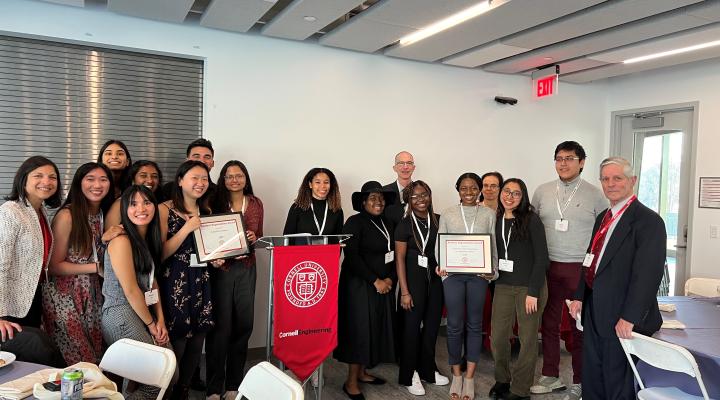Sriramya Nair has joined the faculty of Cornell’s School of Civil and Environmental Engineering (CEE) as an assistant professor. Nair has been at Cornell the past three years as a post-doctoral associate at the Cornell High Energy Synchrotron Source (CHESS) and as a visiting professor in CEE. Her new appointment began in July 2020.
Nair’s research focuses on developing novel cementitious materials and testing techniques. Concrete is one of the most widely-used construction materials in the world. The most common cement used in concrete is called Portland cement and it has been in common usage since the 1800s. The production of Portland cement is responsible for an astounding 7% of the world’s carbon dioxide emissions.
With her research, Nair sees a way to have a large and lasting impact on both construction and climate change.
During her doctoral studies and term as a research associate at the University of Texas-Austin, Nair put magnetic particles into cement paste. This allows a user to apply a magnetic field and harden the slurry instantly instead of having to wait hours for the cement to set. An immediate use for this innovation was found in the oil and gas industry. Well holes are often protected by a casing of cement to prevent collapse and contamination. Using Nair’s innovation, the cement slurry used to create these casings could harden instantly with the application of a magnetic field, preventing possible collapse and ensuring no gasses pass through the hardening cement, creating dangerous fissures.
In addition to creating additives for traditional cement formulations, Nair is also actively exploring alternative possibilities. “Instead of just using 100% Portland cement, which is manufactured by a process that creates a lot of CO2,” says Nair, “I am looking at possible alternate materials. One possibility is fly ash from coal that is activated with sodium hydroxide solution.” Nair is studying this new material at CHESS to see how it compares to traditional cement.
“Because these are new materials and their properties vary a lot across samples,” says Nair, “we want to understand at the micron scale how the different grains that you have inside the material are behaving.” Using CHESS, Nair can see what happens to a small sample of the fly ash-based concrete as stress is being applied. “That is the unique thing about this,” continues Nair, “you get information not just about the final strength and where the concrete fails, but about how the fracture is starting—where is it starting? What is happening as you are loading your sample?”
Nair is also examining novel 3-D printing techniques using magneto-rheological concrete. She then looks at quality and structural stability of 3-D printed concrete using real-time sensing techniques. In the race to find alternate formulations for concrete, it is essential that whatever material replaces Portland cement be at least as strong as the product it is replacing. Nair’s research at CHESS can help ensure this is true.
Nair attended the Indian Institute of Technology (IIT) in Madras for her Bachelor’s degree in civil engineering. “My grandfather was a civil engineer,” says Nair. “He was responsible for the construction and maintenance of dams in India, and later he designed and constructed buildings in my hometown. And my father is a mechanical engineer; so I was always surrounded by engineers when I was growing up.” When Nair was in her third year at IIT she took a concrete technology class that she says put her on the path of construction materials.
Nair then earned an M.S. in civil engineering from the University of California-Davis and her Ph.D. in civil engineering materials at UT-Austin. She worked for a year as a structural design engineer between earning her Master’s and starting her doctoral studies.
Nair is excited to be at Cornell. “There are such great colleagues and facilities here,” says Nair. “I can use CCMR (the Cornell Center for Materials Research) and the synchrotron (CHESS) in my research and I can introduce students to these techniques, which traditionally they might not think of as civil engineering tools.” Nair will be teaching an upper level course in the characterization of structures and materials across length scales in future semesters.




